Top Four Reasons to Travel to Bordeaux!
December 6, 2024
Bordeaux is well known for being the wine capital of the world, and with good reason. Bordeaux produces at least 400 million liters of -…
Read This Post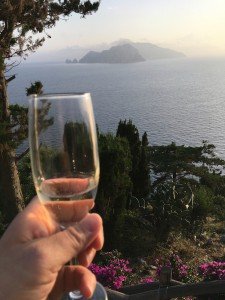 The road is narrow and in places steep, curving along the mountainside heading down toward the sea. Most people descend from the main road on foot or, if that’s too difficult for them, on the back of a scooter. We’re with my old friend Salvatore, though, who used to race cars professionally for Ferrari. He waits patiently while they lower the chain that closes the entrance and proceeds to steer our car down the narrow road.
The road is narrow and in places steep, curving along the mountainside heading down toward the sea. Most people descend from the main road on foot or, if that’s too difficult for them, on the back of a scooter. We’re with my old friend Salvatore, though, who used to race cars professionally for Ferrari. He waits patiently while they lower the chain that closes the entrance and proceeds to steer our car down the narrow road.
We bounce along – the road is made of stone, as is the low wall that separates us from the steep drop to our right. It was once a Roman road, where the carts were brought up from the coast, but legend says it predates the Romans by hundreds of years.
This is the land of Ulysses, where the earth and sun are stark, and the flavors they bring forth intense. If you follow the road to its end, called the Punta Campanella, you will reach the ancient ruins of a temple to Minerva and a Saracen watch tower.
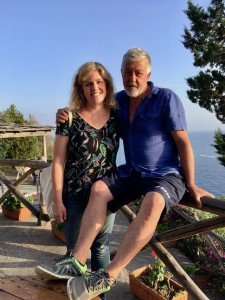 “No one knows of this place,” Salvatore explains in Italian, “No one but the locals. Tourists?” He shakes his head and makes a hand gesture meaning “none.” “Wait until you see it.”
“No one knows of this place,” Salvatore explains in Italian, “No one but the locals. Tourists?” He shakes his head and makes a hand gesture meaning “none.” “Wait until you see it.”
Travel to the Amalfi Coast on an authentic cooking vacation.
This is where legend has it Ulysses passed between what is now the Isle of Capri and the mainland of Italy, where he ordered his seamen stop their ears with beeswax to avoid hearing the Sirens’ call. Bold even in this, Ulysses himself wanted to hear their song and had himself lashed to the mast of his ship.
I clench my hands as we zip along the stone road, the wall of the mountain and the stone wall mere centimeters from either side of the car, until we roll to a stop. A man comes out to greet us. He embraces Salvatore warmly and introduces himself. Giovanni, the owner of this part of paradise. This is his family’s “tenuta,” or farm, where we have landed this lucky day, and he’s here to show it to us. He gestures first to the animals, which my sons observe avidly. “We’ll see them after,” he says, as he leads us further down the hillside.
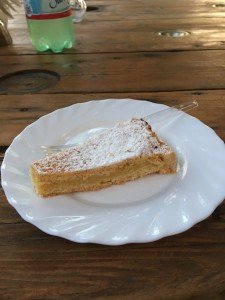 He explains that his farm is mostly olive groves, and lemon, but he has a large garden and orchard as well from which he supplies produce locally. The animals are mostly for fun, because he enjoys it. He leads us toward a small outdoor terrace. “This is as close as you can get to Capri on the mainland,” he says. His voice is soft. We look out over the Tyrrhenian Sea. The sun is setting, the sky positively golden with its light, and Capri hulks large and hazy in the water, a strangely indistinct shadow against the sunset. The water glitters.
He explains that his farm is mostly olive groves, and lemon, but he has a large garden and orchard as well from which he supplies produce locally. The animals are mostly for fun, because he enjoys it. He leads us toward a small outdoor terrace. “This is as close as you can get to Capri on the mainland,” he says. His voice is soft. We look out over the Tyrrhenian Sea. The sun is setting, the sky positively golden with its light, and Capri hulks large and hazy in the water, a strangely indistinct shadow against the sunset. The water glitters.
Our other friend, also named Giovanni, comes down with the farmer’s wife Ilaria and a tray of prosecco and olives for our apperitivo. My husband asks about the cultivation of the olives and the Roman road, my kids entertain themselves throwing olive pits down the mountainside. They ask if they might wander down to the sea. “Not today,” Giovanni answers before explaining that he has goats that roam down there. This entrances the boys and now they try to spot the goats to throw the pits to them. I wonder whether we should move here. Just pull up stakes and find a little plot of land and live off the earth.
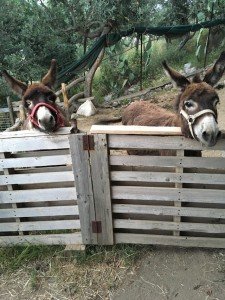 We finish the bottle of prosecco leisurely while I catch up with Salvatore, then we head partway up the hill and settle on another outdoor terrace. “This is where the cheese making happens,” Giovanni explains. “Usually my mother does it.”
We finish the bottle of prosecco leisurely while I catch up with Salvatore, then we head partway up the hill and settle on another outdoor terrace. “This is where the cheese making happens,” Giovanni explains. “Usually my mother does it.”
This of course is why we are here, it is where we bring our culinary travelers on our best-selling cooking vacation to experience a bit of southern Italian cheese making, and a bit of southern Italian life. They have a class on making some of Campania’s most known cheeses, including fresh mozzarella, and then finish it with a lunch of local regional products. “The cows are up in the mountains this time of year,” Giovanni continues, “here it is too hot for them, but we bring the milk down for the class.” His wife brings out what is one of the most delicious tarts I have tasted – perfect consistency to the crust, a tart pungency to the lemon filling. I compliment her and she blushes. We enjoy it with their homemade limoncello and other digestivi – some made from white and dark Mirto berries, from carob pods, oranges, fennel – I start to get tipsy from tasting each variety.
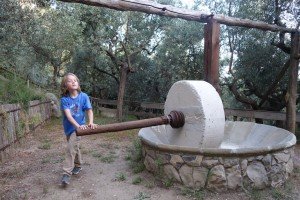 Giovanni, our host, is a true Renaissance man. Soft spoken but inherently curious, he shows us his world. There are amazing works of art and craftsmanship that he has constructed, a wooden map of the world, a functioning hour glass, a recreated olive press made from stones he collected during his work around the tenuta. He beckons me closer, “Look here,” he points toward the fossils in the stone, and I marvel that this man has not only recreated an ancient olive press in his spare time out of the stones he has gathered, but that he has selected ones with particular beauty and significance and has placed them in such a way as to showcase them.
Giovanni, our host, is a true Renaissance man. Soft spoken but inherently curious, he shows us his world. There are amazing works of art and craftsmanship that he has constructed, a wooden map of the world, a functioning hour glass, a recreated olive press made from stones he collected during his work around the tenuta. He beckons me closer, “Look here,” he points toward the fossils in the stone, and I marvel that this man has not only recreated an ancient olive press in his spare time out of the stones he has gathered, but that he has selected ones with particular beauty and significance and has placed them in such a way as to showcase them.
After this (also leisurely) treat we head back to the animals. There are different varieties of sheep and goats, donkeys, pigs, a horse, and different fowl. Giovanni shows our boys a hutch with 8 baby bunnies all sleeping on top of each other. He speaks of a goat whose mother did not have enough milk and who was fed by them – it never quite reacclimated to being with the other goats and now lives more comfortably with the donkeys.
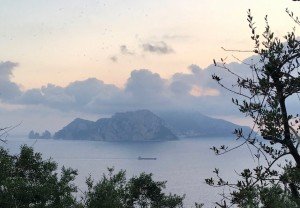 As we walk back up the hill the sun sets. It glows brilliantly red for a moment, and by time we reach the car and say goodbye to our new friends it is gone. Now Capri hulks before us in the sea, no longer a hazy shade rising from the water, but with each stark rock, every forested outcropping visible in the evening light. I could almost reach out and touch it. Ulysses surely could have reached out and touched it, had his arms been not so safely secured.
As we walk back up the hill the sun sets. It glows brilliantly red for a moment, and by time we reach the car and say goodbye to our new friends it is gone. Now Capri hulks before us in the sea, no longer a hazy shade rising from the water, but with each stark rock, every forested outcropping visible in the evening light. I could almost reach out and touch it. Ulysses surely could have reached out and touched it, had his arms been not so safely secured.
By Peg Kern
Get inspired by the Amalfi Coast:
Sign up to receive our newsletter, which includes travel tips, recipes, promotions, and information on our best cooking vacations.
Find more photos, videos, food facts, and travel stories from The International Kitchen on Facebook, Instagram, Pinterest, Twitter, and YouTube.